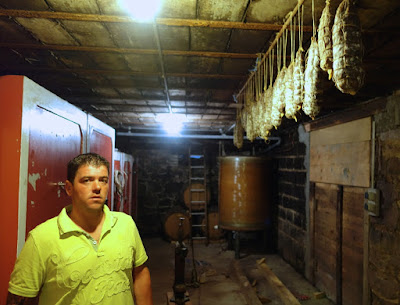A common wine writing trope is to conclude that a wine resembles its maker in some way or another. Nowhere is this less applicable than in the wines of rising-star Beaujolais winemaker Rémi Dufaitre, whose production of Brouilly and Côte de Brouilly (among other wines) is distinguished by its elegance and finesse.
Rémi Dufaitre himself is more direct, an endearing trait, from certain angles. When I arrived at his domaine in Saint-Etienne-des-Ouillières, roughly where the Brouilly appellation meets Beaujolais-Villages, he lost no time asking me upfront about my blog traffic. When I introduced my bike trip companion N, a novelist, Rémi, without missing a beat, asked, "How many books did you sell?"
The no-bullshit approach, in this case, reflects the confidence of a young winemaker who enjoys broad support among his forebears in the region. Originally from Saint-Etienne-La-Varenne, Dufaitre has known since birth his friend and Brouilly neighbor Jean-Claude Lapalu. Influential Fleurie winemaker Jean-Louis Dutraive is Dufaitre's cousin. And while Dufaitre and his wife Laurence only began bottling their own wines in 2010, their work soon attracted the attention of Villié-Morgon legend Jean Foillard, who has said he considers Dufaitre among the best of the younger generation of Beaujolais winemakers. Who cares if he possesses the combative, ball-breaking temperament of a mob enforcer, when the wines are this good?
The Dufaitres cultivate 12ha total, mostly gamay, although two are sandy-soiled chardonnay parcels from which they produce a pristine, silvery Beaujolais Blanc.
My friends and I visited in April, a period where most winemakers we visited were plowing their vines. Dufatire was no exception. He began conversion to organic viticulture in 2010, the same year he began bottling his own wines.
It was late afternoon when my friends and I arrived at Domaine de Botheland. Dufaitre had kindly arranged for us to go visit Jean-Claude Lapalu first, so we saved the tour of his own facilities for the following morning. Instead we shared a few sips of Dufaitre's Brouilly 2014 as we made introductions. 2014 in Beaujolais was more generous than the preceding years; the reds for now evince a voluptuousness of fruit that belies their relatively low alcohol.
Carbonic fermentation chez Dufaitre occurs in lidded cement vats. From what I understand, the only efforts Rémi makes at temperature control are to bring the grapes in early, and if necessary, to let them sit for a time in a refrigerated room before loading them via forklift into the fermentation vats. Like his neighbor Lapalu, he seeks a long, relatively cool fermentation, to conserve finesse.
Everyone in the region, Dufaitre included, seems since then to have changed their minds about 2013 cru Beaujolais. The wines have noticeably perked up since release, attaining good length and very refined structure. I expect that if I were to visit the Dufaitres again in 10 years, that 2013 Côte de Brouilly would be the star wine of the evening.
 |
| The drinking room. |
Dufaitre also produces a Beaujolais-Villages cuvée entitled "L'Aire de Rien" which sees slightly longer barrel elevage, and no addition of sulfur. In this it could be loosely comparred to Jean-Claude Lapalu's "Eau Forte" and "Tentation" cuvées. Like these, the "L'Aire de Rien" is a hit at Paris' natural wine bars, and the Dufaitres produced slightly more than usual in 2014. It seems significant, though, that both Dufatire and Lapalu categorize separately their strictly-no-sulfur cuvées. In this the winemakers are arguably more transparent than many of the original Villié-Morgon gang, whose sulfur use is very low, infrequent, but above all, mostly undeclared.
 |
| Rémi also ages sausages. |
 |
| Dufaitre also makes a gamay pét-nat, in collaboration with his friend France Gonzalvez. It's the same wine, sold under two different labels. Dufaitre's sports a label drawn by Laurence. |
Apropos of this, Dufaitre over dinner announced that he and his ideological forebears in Villié-Morgon intend next April to organise a smaller satellite tasting to the Beaujoloise. "Like Les Pénitantes?" I asked, referring to the hyper-insular, self-congratulatory satellite tasting to La Renaissance des Appellations in Angers.
"Like Les Pénitantes," he confirmed. "We'll all get together among our own, those who have the same ideas about wine. It wears me out, these salons, having to share the region with people who [don't have the same ideas about wine]."
I began to argue that this was a terrible idea, on the grounds that if Foillard, Dufaitre et al are disappointed by the work of their neighbors, they ought to engage more with them, not less. But you don't win an argument with Rémi Dufaitre, you just get called a wanker and he refills your glass.
In his defense, I can see why passions run high about what might, to oursiders, seem to be obscure shadings of aesthetic differences among winemakers whose work is considered natural. At stake is the eventual redemption of the region's reputation, and, of course, the word natural itself.
 |
| We sent our regards, via double-selfie, to our mutual friends in NYC, his importers. |
Laurence and Rémi Dufaitre
Domaine de Botheland
69460 Saint-Étienne-des-Oullières
Tel: 04 74 03 55 69
Related Links:
Beaujolais Bike Trip 2015:
Jean-Claude Lapalu, Saint-Etienne-La-Varenne
Benoit Camus, Ville-sur-Jarnioux
Beaujolais Bike Trip 2011:
Karim Vionnet, Villié-Morgon
Café de la Bascule, Fleurie
Isabelle et Bruno Perraud, Vauxrenard
Le Coq à Juliènas, Juliènas
Le Relais des Caveaux, Villié-Morgon
L'Atelier du Cuisiner, Villié-Morgon
A far better reported visit to the Dufaitres by Bert at Wine Terroirs.








No comments:
Post a Comment